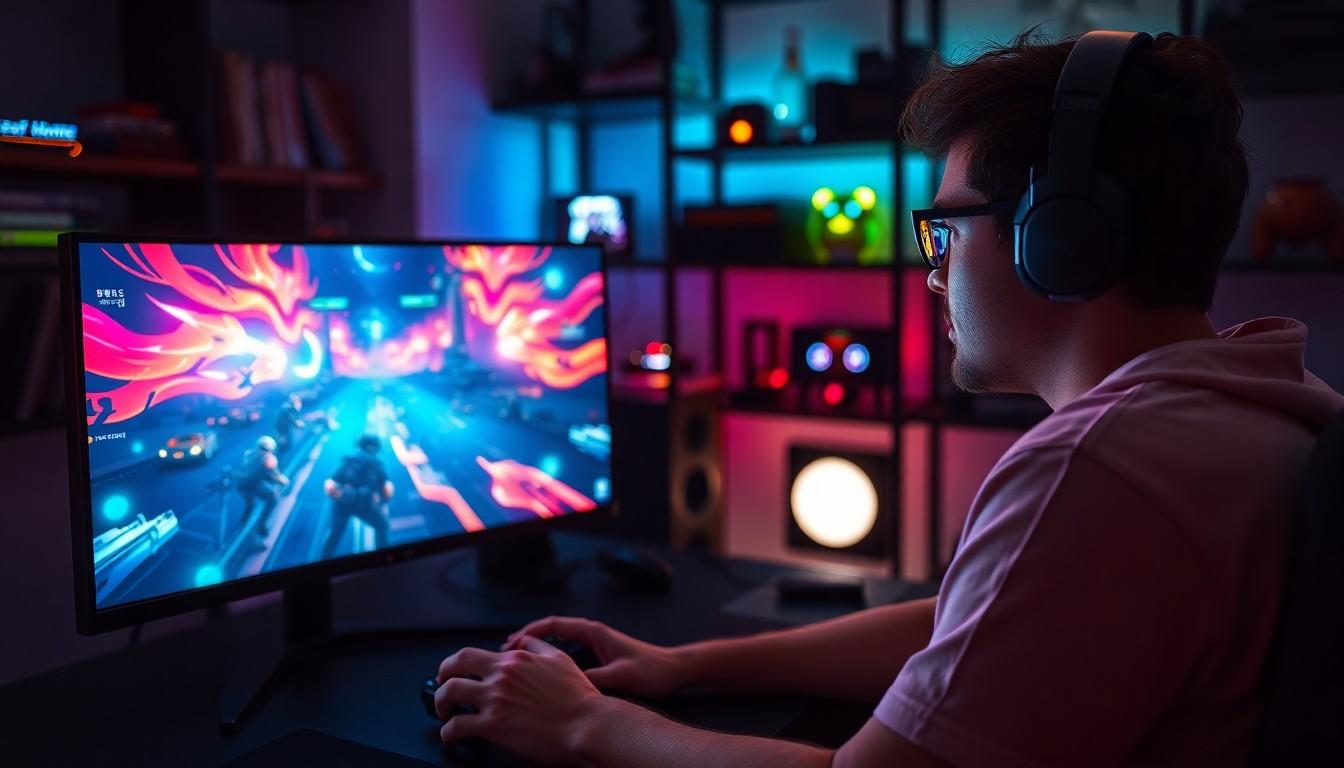In the ever-evolving world of gaming, one technology stands out like a hero in a pixelated universe: OLED. Imagine colors so vibrant they make a rainbow look dull and blacks so deep they could swallow a whole galaxy. That’s the magic of OLED gaming. It’s like stepping into a virtual reality where every detail pops and every shadow lurks with a sinister charm.
OLED Gaming
OLED technology revolutionizes gaming visuals by delivering stunning image quality. Rich colors enhance every gaming session, allowing players to experience vibrant environments. Deep blacks elevate contrast, highlighting details in shadows that standard displays often miss. This capability creates an immersive atmosphere, captivating gamers in virtual worlds.
Quick response times temperature improve gameplay fluidity, reducing motion blur in fast-paced action. Input lag is minimal, providing a seamless experience that gamers highly appreciate. Additionally, OLED displays adapt well to different resolutions, ensuring compatibility with various gaming consoles and PCs.
In recent years, more gaming monitors and televisions incorporate OLED technology. Major brands, including LG and Sony, have introduced OLED gaming displays that cater to competitive and casual gamers alike. Screen sizes vary, allowing players to choose setups that suit their gaming preferences.
HDR (High Dynamic Range) support enhances the visual experience further. High brightness levels in OLED screens reveal intricate details and color gradients, particularly in games that utilize diverse lighting effects. Gamers gain a competitive edge, as they can spot enemies in darker environments with greater ease.
Purchasing options for OLED displays are expanding as demand rises. Prices remain higher than traditional LCDs, yet the superior visual fidelity justifies the investment for serious gamers. Flexibility in design, such as ultra-thin profiles and curved screens, adds to the appeal of OLED technology in gaming.
Overall, OLED gaming offers exceptional visuals, responsiveness, and an engaging experience. Players embracing this technology discover a new standard in gaming that significantly enhances their playtime enjoyment.
Benefits Of OLED Displays

OLED displays offer significant advantages in gaming, particularly with color and contrast enhancements.
Improved Color Accuracy
Color accuracy defines the visual quality in gaming. OLED technology delivers precise color representation, ensuring vivid hues are displayed as designers intended. Gamers experience a palette that remains true across various lighting conditions, which enhances immersion. Whether in a bright daylight scene or a dark cave, colors remain consistent and engaging. The ability of OLED displays to produce pure blacks contributes to superior color depth, showcasing bright colors without distortion. This accuracy allows players to distinguish subtle differences in shades, an advantage during gameplay. Brands like LG and Sony excel in providing OLED displays equipped with advanced color calibration, further elevating visual performance.
Enhanced Contrast Ratios
Contrast ratios significantly impact the overall viewing experience during gaming. OLED panels excel in this area by turning individual pixels on and off, achieving true black levels. This capability results in striking contrasts between light and dark scenes, avoiding the grayish blacks common in traditional displays. Players gain advantages in dark environments, spotting enemies hidden in shadows. Enhancing an already thrilling experience, the increased contrast also boosts overall image depth, creating a more lifelike scene. Additionally, scenes with bright elements against dark backgrounds become more defined and captivating. As gaming graphics continue to improve, the contrast ratios of OLED displays play a crucial role in showcasing this advanced detail.
Potential Drawbacks Of OLED Gaming
Despite the many advantages, OLED gaming presents some drawbacks that gamers should consider.
Burn-In Concerns
Burn-in issues remain a significant drawback of OLED technology. Static images, such as HUD elements from games, may lead to permanent ghosting if displayed for extended periods. This phenomenon occurs when certain pixels degrade faster than others, resulting in noticeable after-images on the screen. Gamers who play with fixed elements, like health bars or score counters, might experience this more frequently. It’s essential for users to adjust settings and implement screen savers to minimize this risk. Regularly changing content on the screen can also help prevent burn-in, ensuring a longer lifespan for the display.
Limited Brightness Levels
Limited brightness levels pose another challenge with OLED displays. Compared to some LCD counterparts, OLED panels may not reach the same peak brightness in well-lit environments. Sunlight or bright indoor areas can hinder visibility and detail in certain scenes, especially when playing HDR content. Brightness rivalries can lead to less impactful highlights, decreasing the overall visual experience. Gamers who play in diverse lighting scenarios may find this limitation frustrating. Opting for OLED with higher brightness capabilities might alleviate this issue, enabling a more enjoyable gaming experience across different settings.
Game Performance On OLED
Gaming performance shines on OLED displays due to their impressive technical capabilities. Quick response times and high refresh rates enhance gameplay experiences, providing smooth visuals and reducing motion blur.
Response Times and Refresh Rates
Response times on OLED panels often reach as low as 1ms, which is ideal for fast-paced gaming. Players benefit from reduced lag, giving them an edge in competitive scenarios. High refresh rates, typically between 120Hz and 240Hz, support fluid motion during intense action. Gamers enjoy a seamless experience with no tearing, as OLED technology synchronizes well with variable refresh rate technologies like NVIDIA G-SYNC and AMD FreeSync. Motion clarity and input responsiveness combine to create an immersive gaming environment.
Visual Experience with HDR
High Dynamic Range (HDR) elevates visual performance on OLED displays. With HDR support, OLED panels deliver heightened contrast and a broader color gamut. Shadows and highlights appear more distinct with increased depth. Players appreciate enhanced visibility in darker scenes, allowing them to spot enemies effortlessly. The vivid colors produced by HDR technology immerse gamers in rich landscapes and detailed game worlds. Overall, HDR capabilities on OLED significantly enhance visual storytelling, making every gaming session more engaging and enjoyable.
OLED gaming represents a significant leap in visual technology that transforms how players engage with their favorite titles. The combination of vibrant colors deep blacks and quick response times creates an immersive experience that standard displays simply can’t match. As more gamers seek out high-quality visuals and responsive gameplay OLED technology is becoming increasingly accessible despite its higher price point.
While challenges like burn-in and limited brightness in certain environments exist they can often be managed with proper care and the right settings. As manufacturers continue to innovate and improve OLED displays gamers can look forward to even better performance and enhanced visual storytelling. Embracing OLED technology means stepping into a new era of gaming where every detail comes to life like never before.




